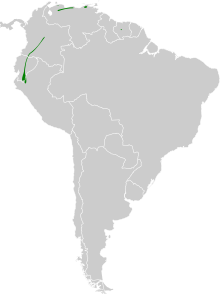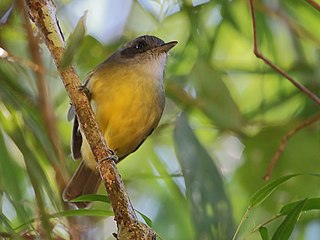
The plain antvireo is a passerine bird species in subfamily Thamnophilinae of family Thamnophilidae, the "typical antbirds". It is found in Mexico, every Central American country except El Salvador, on both Trinidad and Tobago, and in every mainland South American country except Chile, French Guiana, Suriname, and Uruguay.

The russet antshrike is a passerine bird in subfamily Myrmornithinae of family Thamnophilidae, the "typical antbirds". It is found in Mexico, every Central American country except El Salvador, Colombia, Ecuador, Venezuela, and possibly Peru.

The banded antbird – sometimes called banded antwren despite not being close to the true antwrens – is a species of bird in subfamily Thamnophilinae of family Thamnophilidae, the "typical antbirds". It is found in Bolivia, Brazil, Colombia, Ecuador, Peru, and Venezuela.

Dysithamnus is a genus of insectivorous passerine birds in the antbird family, Thamnophilidae. Species in this genus are known as antvireos.
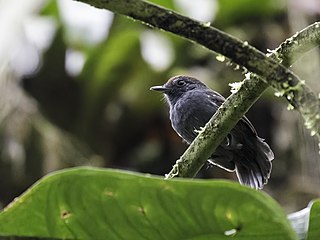
The bicolored antvireo is a Near Threatened insectivorous bird in subfamily Thamnophilinae of family Thamnophilidae, the "typical antbirds". It is found in Colombia, Ecuador, and Peru.

The plumbeous antvireo is a Vulnerable species of bird in subfamily Thamnophilinae of family Thamnophilidae, the "typical antbirds". It is endemic to Brazil.

The spot-crowned antvireo is a species of bird in subfamily Thamnophilinae of family Thamnophilidae, the "typical antbirds". It is found in Colombia, Costa Rica, Ecuador, and Panama.

The pearly antshrike is a species of bird in subfamily Thamnophilinae of family Thamnophilidae, the "typical antbirds". It is found in Brazil, Colombia, Ecuador, Peru, and Venezuela.

The plumbeous antbird is a species of bird in the family Thamnophilidae.

The plain-winged antwren is a species of bird in subfamily Thamnophilinae of family Thamnophilidae, the "typical antbirds". It is found in Brazil, Colombia, Ecuador, Guyana, Venezuela, and possibly Suriname.

The rufous-tailed stipplethroat, formerly called the rufous-tailed antwren, is a species of insectivorous bird in subfamily Thamnophilinae of family Thamnophilidae, the "typical antbirds". It is found in Brazil, Colombia, Ecuador, and Peru.

The rufous-backed stipplethroat is a species of bird in subfamily Thamnophilinae of family Thamnophilidae, the "typical antbirds". It is found in Brazil, Colombia, Ecuador, Peru, and Venezuela. In its complex taxonomic history, Epinecrophylla haematonota has also been called the rufous-backed antwren, stipple-throated antwren, Napo stipple-throated antwren, and western stipple-throated antwren.
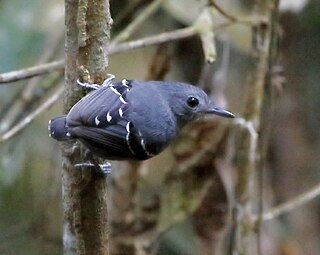
The plain-throated antwren is a species of bird in subfamily Thamnophilinae of family Thamnophilidae, the "typical antbirds". It is found in Bolivia, Brazil, Colombia, Ecuador, and Peru.

The long-winged antwren is a species of bird in subfamily Thamnophilinae of family Thamnophilidae, the "typical antbirds". It is found in Bolivia, Brazil, Colombia, Ecuador, French Guiana, Guyana, Peru, Suriname, and Venezuela.

The Amazonian streaked antwren is a species of bird in subfamily Thamnophilinae of family Thamnophilidae, the "typical antbirds". It is found in Bolivia, Brazil, Colombia, Ecuador, Peru, and Venezuela.
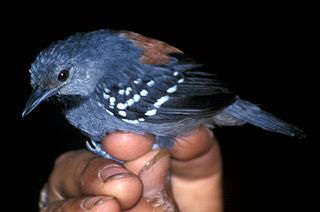
The ornate stipplethroat, formerly called the ornate antwren, is a species of bird in subfamily Thamnophilinae of family Thamnophilidae, the "typical antbirds". It is found in Bolivia, Brazil, Colombia, Ecuador, and Peru.

The foothill stipplethroat, previously called the foothill antwren, is a species of bird in subfamily Thamnophilinae of family Thamnophilidae, the "typical antbirds". It is found in Colombia, Ecuador, and Peru.
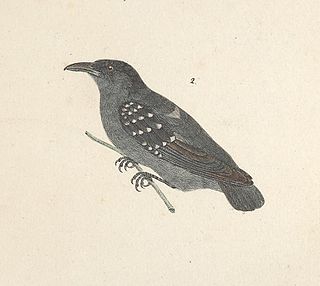
The spot-winged antshrike is a species of bird in subfamily Myrmornithinae of family Thamnophilidae, the "typical antbirds". It is found in Bolivia, Brazil, Colombia, Ecuador, Guyana, Peru, Suriname, Venezuela, and possibly French Guiana.

The dusky-throated antshrike is a species of bird in subfamily Thamnophilinae of family Thamnophilidae, the "typical antbirds". It is found in Bolivia, Brazil, Colombia, Ecuador, French Guiana, Guyana, Peru, Suriname, and Venezuela.

The rusty-winged antwren is a species of bird in subfamily Thamnophilinae of family Thamnophilidae, the "typical antbirds". It is found in Bolivia, Brazil, Colombia, Ecuador, Guyana, Panama, Peru, Suriname, and Venezuela.

